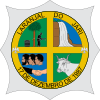Laranjal do Jari
| Município de Laranjal do Jari "Beiradão"
Laranjal do Jari
|
|||
|---|---|---|---|
|
Park in Laranjal do Jari
|
|||
|
|
|||
| Coordinates | 0 ° 51 ′ S , 52 ° 31 ′ W | ||
 Location of Laranjal do Jari in the state of Amapá Location of Laranjal do Jari in the state of Amapá
|
|||
| Symbols | |||
|
|||
| founding | 17th December 1987 | ||
| Basic data | |||
| Country | Brazil | ||
| State | Amapá | ||
| ISO 3166-2 | BR-AP | ||
| Região intermediária | Macapá (since 2017) | ||
| Região imediata | Laranjal do Jari (since 2017) | ||
| height | 22 m | ||
| climate | Am, tropical | ||
| surface | 30,783 km² | ||
| Residents | 39,942 (2010) | ||
| density | 1.3 Ew. / km² | ||
| estimate | 50,410 (July 1, 2019) | ||
| Parish code | IBGE : 1600279 | ||
| Time zone | UTC −3 | ||
| Website | laranjaldojari.ap.gov.br (Brazilian Portuguese) | ||
| politics | |||
| City Prefect | Márcio Clay da Costa Serrão (2017–2020) | ||
| Political party | Partido Republicano Brasileiro (PRB) | ||
| economy | |||
| GDP | 559,807 thousand R $ 12,246 R $ per person (2015) |
||
| HDI | 0.665 (2010) | ||
Laranjal do Jari , officially Portuguese Município de Laranjal do Jari , is a small town with a large municipality in the Brazilian state of Amapá in the Região Norte . It is located on the Rio Jari , which flows into the Amazon , and is around 275 km from the capital Macapá . The population was estimated to be 50,410 as of July 1, 2019. The inhabitants, who live in the almost 30,783 km² area like the state of Brandenburg , are called Laranjalenser (Portuguese laranjalenses ). The population density in 2010 was 1.3 people per km².
geography
The landscape and biome are predominantly shaped by the Amazon rainforest . In the south the municipality is bounded by the Amazon, in the west it forms the border with the state of Pará . The climate is tropical according to the Köppen and Geiger Am climate classification . The average temperature is 27.2 ° C. There is a lot of precipitation and few dry spells.
The seat of the municipality is in a bend in the Rio Jari. East lies the approximately 5017 square kilometers Nutzreservat Rio Cajari , north the nature reserve Parque Nacional Montanhas do Tumucumaque . In the north it forms a green border with Suriname and French Guiana .
history
The area was under the municipality of Mazagão until 1987 and became a legally independent municipality on December 17, 1987. It was previously known as "Beiradão" .
In 2017, the Instituto Brasileiro de Geografia e Estatística changed the assignment to geostatistical regions and assigned the municipality to the Região geográfica imediata Laranjal do Jari and the Região geográfica intermediária Macapá .
The Rio Jari formed an important traffic route for the settlement history of the Amazon.
City administration
Executive: In the local elections in 2016, Márcio Clay da Costa Serrão became city prefect (mayor) for the term from 2017 to 2020, who ran for the Partido Republicano Brasileiro (PRB).
Standard of living
The human development index for cities, abbreviated HDI (Portuguese: IDH-M ), was at the very low value of 0.349 in 1991, at the low value of 0.481 in 2000, and at the mean value of 0.665 in 2010.
Web links
- City Prefecture website , Prefeitura Municipal (Brazilian Portuguese)
- Instituto Brasileiro de Geografia e Estatística (IBGE): Laranjal do Jari - panorama , updated statistics (Brazilian Portuguese)
- Governo do Estado do Amapá, Secretaria de Estado do Planejamento: Síntese de informações socioeconômicas do município Laranjal do Jari. SEPLAN, Amapá 2017 (Brazilian Portuguese)
Individual evidence
- ↑ a b c d Instituto Brasileiro de Geografia e Estatística (IBGE): Amapá: Laranal do Jari. Retrieved September 1, 2019 (Brazilian Portuguese).
- ↑ a b Márcio Serrão 10. In: com.br. Eleições 2016, accessed April 6, 2018 (Brazilian Portuguese).
- ↑ Climate Laranjal do Jari: Weather, climate table & climate diagram. In: climate-data.org. de.climate-data.org, accessed on April 6, 2018 .
- ↑ Instituto Brasileiro de Geografia e Estatística (IBGE): [ Internet source: archiv-url invalid Divisão Regional do Brasil. ] 2017, archived from the original ; accessed on January 28, 2017 .
- ^ Atlas do desenvolvimento humano no Brasil - Laranal do Jari . Retrieved April 6, 2018 (Brazilian Portuguese).




